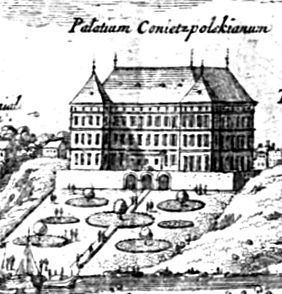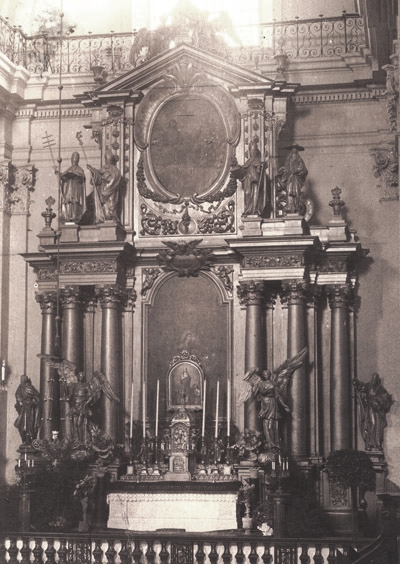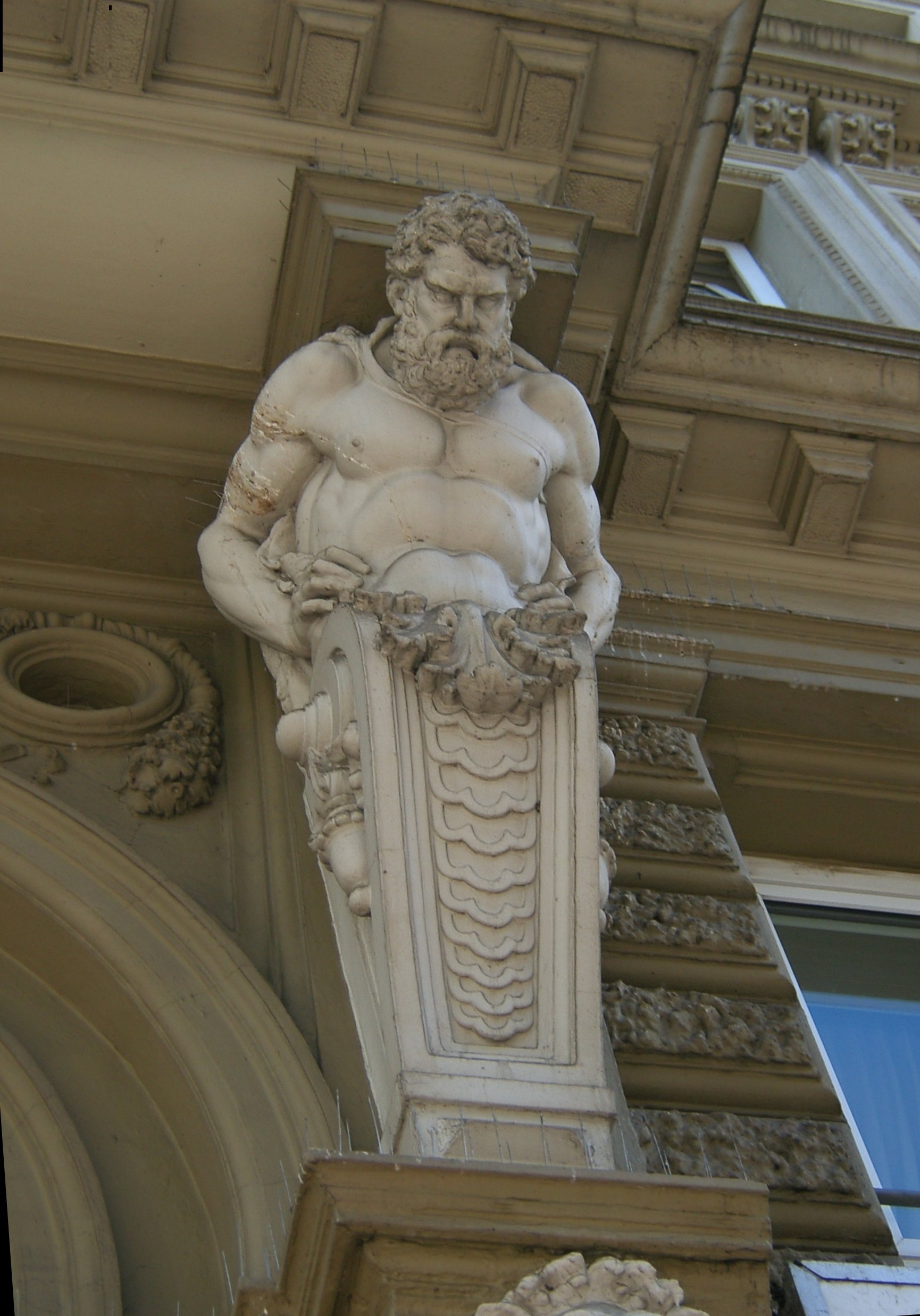|
Tyszkiewicz Palace, Warsaw
Tyszkiewicz Palace ( pl, Pałac Tyszkiewiczów), also known as Tyszkiewicz–Potocki Palace, is a rebuilt palace at 32 ''Krakowskie Przedmieście'' in Warsaw, Poland. It is one of the most beautiful Neoclassical-style buildings in the city. History The original palace was built by Ludwik Tyszkiewicz, a Field Hetman of Lithuania. Construction began in 1785, initially to plans by Stanisław Zawadzki, and was finished in 1792 in the Neoclassical style, to a design by Jan Chrystian Kamsetzer. In 1840, the palace was bought by the Potocki family. During the interwar period, the building was home to ''Bank Gospodarstwa Krajowego'' and later to the Polish Academy of Literature. Burned in 1944, the palace was rebuilt after World War II and is now a property of Warsaw University. The palace's relatively modest west façade, on ''Krakowskie Przedmieście'', is embellished with some fine stuccowork. The central balcony is supported by four elegant stone Atlantes carved in 1787 by An ... [...More Info...] [...Related Items...] OR: [Wikipedia] [Google] [Baidu] |
Warsaw
Warsaw ( pl, Warszawa, ), officially the Capital City of Warsaw,, abbreviation: ''m.st. Warszawa'' is the capital and largest city of Poland. The metropolis stands on the River Vistula in east-central Poland, and its population is officially estimated at 1.86 million residents within a greater metropolitan area of 3.1 million residents, which makes Warsaw the 7th most-populous city in the European Union. The city area measures and comprises 18 districts, while the metropolitan area covers . Warsaw is an Alpha global city, a major cultural, political and economic hub, and the country's seat of government. Warsaw traces its origins to a small fishing town in Masovia. The city rose to prominence in the late 16th century, when Sigismund III decided to move the Polish capital and his royal court from Kraków. Warsaw served as the de facto capital of the Polish–Lithuanian Commonwealth until 1795, and subsequently as the seat of Napoleon's Duchy of Warsaw. Th ... [...More Info...] [...Related Items...] OR: [Wikipedia] [Google] [Baidu] |
Façade
A façade () (also written facade) is generally the front part or exterior of a building. It is a Loanword, loan word from the French language, French (), which means 'frontage' or 'face'. In architecture, the façade of a building is often the most important aspect from a design standpoint, as it sets the tone for the rest of the building. From the engineering perspective, the façade is also of great importance due to its impact on Efficient energy use, energy efficiency. For historical façades, many local zoning regulations or other laws greatly restrict or even forbid their alteration. Etymology The word is a loanword from the French , which in turn comes from the Italian language, Italian , from meaning 'face', ultimately from post-classical Latin . The earliest usage recorded by the ''Oxford English Dictionary'' is 1656. Façades added to earlier buildings It was quite common in the Georgian architecture, Georgian period for existing houses in English towns to be give ... [...More Info...] [...Related Items...] OR: [Wikipedia] [Google] [Baidu] |
Neoclassical Architecture In Warsaw
Neoclassical or neo-classical may refer to: * Neoclassicism or New Classicism, any of a number of movements in the fine arts, literature, theatre, music, language, and architecture beginning in the 17th century ** Neoclassical architecture, an architectural style of the 18th and 19th centuries ** Neoclassical sculpture, a sculptural style of the 18th and 19th centuries ** New Classical architecture, an overarching movement of contemporary classical architecture in the 21st century ** in linguistics, a word that is a recent construction from New Latin based on older, classical elements * Neoclassical ballet, a ballet style which uses traditional ballet vocabulary, but is generally more expansive than the classical structure allowed * The "Neo-classical period" of painter Pablo Picasso immediately following World War I * Neoclassical economics, a general approach in economics focusing on the determination of prices, outputs, and income distributions in markets through supply and de ... [...More Info...] [...Related Items...] OR: [Wikipedia] [Google] [Baidu] |
Houses Completed In 1792
A house is a single-unit residential building. It may range in complexity from a rudimentary hut to a complex structure of wood, masonry, concrete or other material, outfitted with plumbing, electrical, and heating, ventilation, and air conditioning systems.Schoenauer, Norbert (2000). ''6,000 Years of Housing'' (rev. ed.) (New York: W.W. Norton & Company). Houses use a range of different roofing systems to keep precipitation such as rain from getting into the dwelling space. Houses may have doors or locks to secure the dwelling space and protect its inhabitants and contents from burglars or other trespassers. Most conventional modern houses in Western cultures will contain one or more bedrooms and bathrooms, a kitchen or cooking area, and a living room. A house may have a separate dining room, or the eating area may be integrated into another room. Some large houses in North America have a recreation room. In traditional agriculture-oriented societies, domestic animals such as c ... [...More Info...] [...Related Items...] OR: [Wikipedia] [Google] [Baidu] |
Palaces In Warsaw
A palace is a grand residence, especially a royal residence, or the home of a head of state or some other high-ranking dignitary, such as a bishop or archbishop. The word is derived from the Latin name palātium, for Palatine Hill in Rome which housed the Imperial residences. Most European languages have a version of the term (''palais'', ''palazzo'', ''palacio'', etc.), and many use it for a wider range of buildings than English. In many parts of Europe, the equivalent term is also applied to large private houses in cities, especially of the aristocracy; often the term for a large country house is different. Many historic palaces are now put to other uses such as parliaments, museums, hotels, or office buildings. The word is also sometimes used to describe a lavishly ornate building used for public entertainment or exhibitions such as a movie palace. A palace is distinguished from a castle while the latter clearly is fortified or has the style of a fortification, whereas a pa ... [...More Info...] [...Related Items...] OR: [Wikipedia] [Google] [Baidu] |
Kazimierzowski Palace
The Kazimierz Palace ( pl, Pałac Kazimierzowski) is a rebuilt palace in Warsaw, Poland. It is adjacent to the Royal Route, at '' Krakowskie Przedmieście 26/28''. Originally built in 1637-41, it was first rebuilt in 1660 for King John II Casimir ( pl, Jan II Kazimierz Waza, from whom it takes its name) and again in 1765-68, by Domenico Merlini, for the Corps of Cadets established by King Stanisław II Augustus. Since 1816, the Kazimierz Palace has served intermittently as the seat of Warsaw University (which was closed by the Russian Imperial authorities after each Uprising on the part of their Polish subjects, and in 1939-44 by the Germans). History Origin The Kazimierz Palace was erected in 1637-41 for King Władysław IV in the mannerist-early Baroque style as a ''villa suburbana'' ( suburban villa) christened the ''Villa Regia'' (Latin for "Royal Villa"), to the design of Italian architect Giovanni Trevano. It was constructed as a rectangular building with corner towe ... [...More Info...] [...Related Items...] OR: [Wikipedia] [Google] [Baidu] |
Presidential Palace, Warsaw
The Presidential Palace (Polish language, Polish: ''Pałac Prezydencki'') is the official residence of the Polish List of heads of state of Poland, head of state and president alongside the Belweder Palace, located in Warsaw, Poland. Originally constructed in 1643 as an aristocratic mansion, it was rebuilt and remodelled several times over the course of its existence by notable architects. The current neoclassical architecture, neoclassical palace was completed in 1818. Throughout its history, the palace was a venue for important historical events in Polish, European, and world history. In 1791, the facility hosted authors and advocates of the Constitution of May 3, 1791, the first modern European constitution. In 1818, the palace began its ongoing career as a governmental structure when it became the seat of the Viceroy (Namiestnik of the Kingdom of Poland, ''namiestnik'') of Congress Poland. Following Poland's resurrection after World War I, in 1918, the building was taken over ... [...More Info...] [...Related Items...] OR: [Wikipedia] [Google] [Baidu] |
Holy Cross Church, Warsaw
The Church of the Holy Cross ( pl, Bazylika Świętego Krzyża) is a Roman Catholic house of worship in Warsaw, Poland. Located on ''Krakowskie Przedmieście'' opposite the main Warsaw University campus, it is one of the most notable Baroque churches in Poland's capital. The Holy Cross Church is currently administered by the Missionary Friars of Vincent de Paul. History As early as the 15th century, a small wooden chapel of the Holy Cross had been erected here. In 1526 the chapel was demolished, and a newer church was erected. Refurbished and extended by Paweł Zembrzuski in 1615, the church was too small to fill the needs of the growing city. Initially located well outside the city limits, by the 17th century it had become one of the main churches in the southern suburb (''przedmieście'') of the city that had in 1596 become Poland's capital. In 1653 Queen Marie Louise Gonzaga gave the church to the French order of Missionary Friars of Vincent de Paul. However, three years ... [...More Info...] [...Related Items...] OR: [Wikipedia] [Google] [Baidu] |
Atlas (architecture)
In European architectural sculpture, an atlas (also known as an atlant, or atlante or atlantid; plural atlantes)''Aru-Az , Michael Delahunt ArtLex Art Dictionary , 1996–2008. is a support sculpted in the form of a man, which may take the place of a , a or a . The Roman term for such a sculptural support is |
Stucco
Stucco or render is a construction material made of aggregates, a binder, and water. Stucco is applied wet and hardens to a very dense solid. It is used as a decorative coating for walls and ceilings, exterior walls, and as a sculptural and artistic material in architecture. Stucco can be applied on construction materials such as metal, expanded metal lath, concrete, cinder block, or clay brick and adobe for decorative and structural purposes. In English, "stucco" sometimes refers to a coating for the outside of a building and "plaster" to a coating for interiors; as described below, however, the materials themselves often have little to no differences. Other European languages, notably Italian, do not have the same distinction; ''stucco'' means ''plaster'' in Italian and serves for both. Composition The basic composition of stucco is cement, water, and sand. The difference in nomenclature between stucco, plaster, and mortar is based more on use than composition. Until ... [...More Info...] [...Related Items...] OR: [Wikipedia] [Google] [Baidu] |
University Of Warsaw
The University of Warsaw ( pl, Uniwersytet Warszawski, la, Universitas Varsoviensis) is a public university in Warsaw, Poland. Established in 1816, it is the largest institution of higher learning in the country offering 37 different fields of study as well as 100 specializations in humanities, technical, and the natural sciences. The University of Warsaw consists of 126 buildings and educational complexes with over 18 faculties: biology, chemistry, journalism and political science, philosophy and sociology, physics, geography and regional studies, geology, history, applied linguistics and philology, Polish language, pedagogy, economics, law and public administration, psychology, applied social sciences, management and mathematics, computer science and mechanics. The University of Warsaw is one of the top Polish universities. It was ranked by ''Media in Poland, Perspektywy'' magazine as best Polish university in 2010, 2011, 2014, and 2016. International rankings such as ARWU an ... [...More Info...] [...Related Items...] OR: [Wikipedia] [Google] [Baidu] |
Poland
Poland, officially the Republic of Poland, is a country in Central Europe. It is divided into 16 administrative provinces called voivodeships, covering an area of . Poland has a population of over 38 million and is the fifth-most populous member state of the European Union. Warsaw is the nation's capital and largest metropolis. Other major cities include Kraków, Wrocław, Łódź, Poznań, Gdańsk, and Szczecin. Poland has a temperate transitional climate and its territory traverses the Central European Plain, extending from Baltic Sea in the north to Sudeten and Carpathian Mountains in the south. The longest Polish river is the Vistula, and Poland's highest point is Mount Rysy, situated in the Tatra mountain range of the Carpathians. The country is bordered by Lithuania and Russia to the northeast, Belarus and Ukraine to the east, Slovakia and the Czech Republic to the south, and Germany to the west. It also shares maritime boundaries with Denmark and Sweden. ... [...More Info...] [...Related Items...] OR: [Wikipedia] [Google] [Baidu] |
.jpg)






